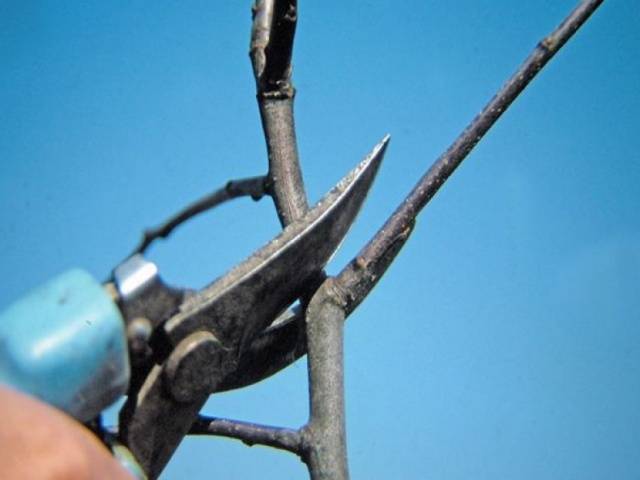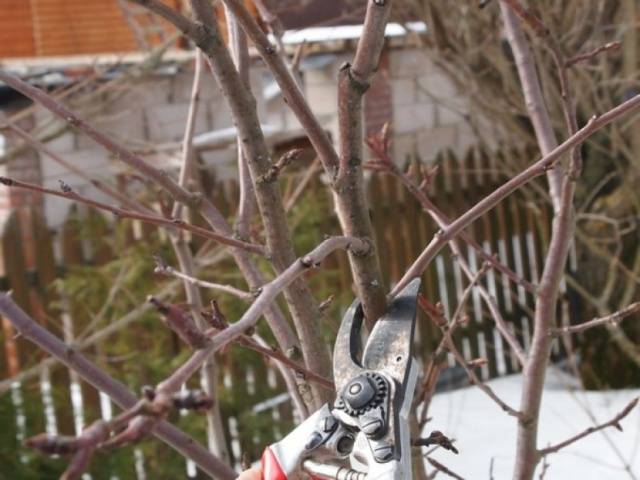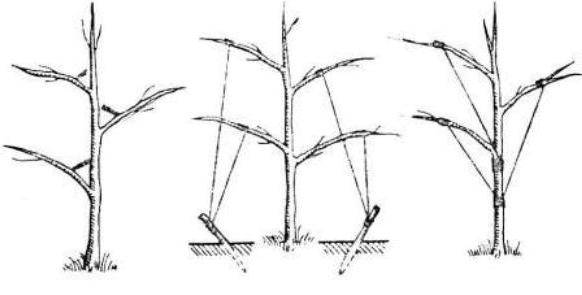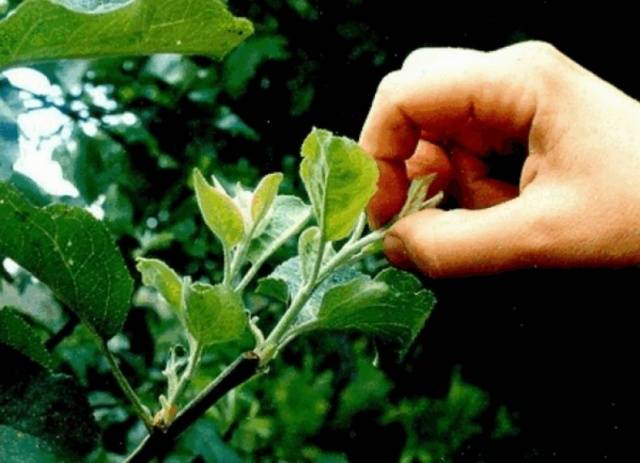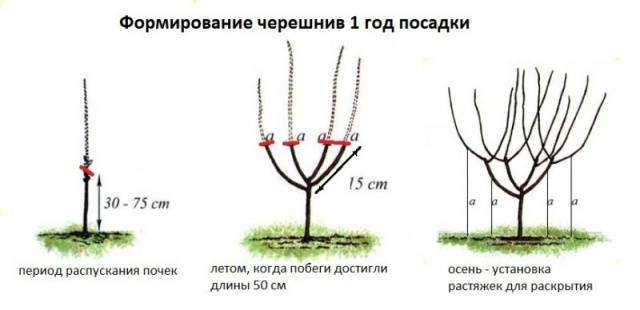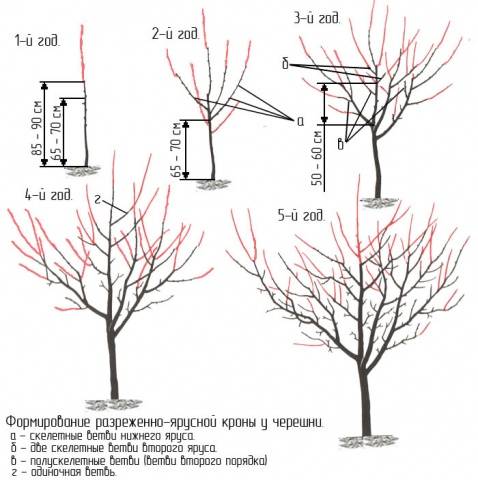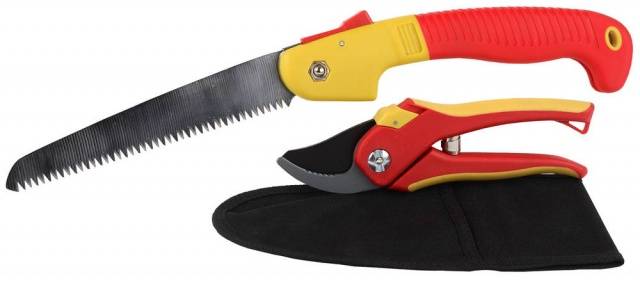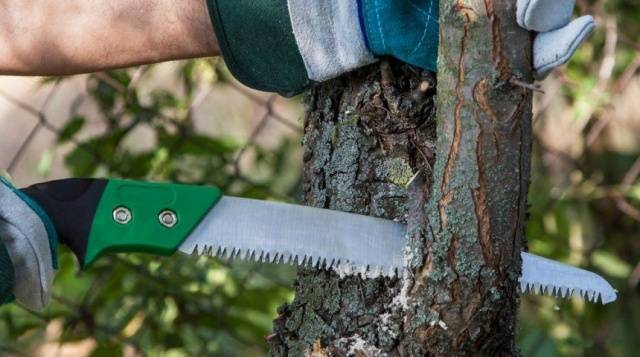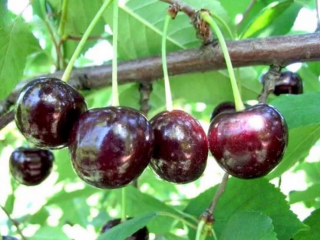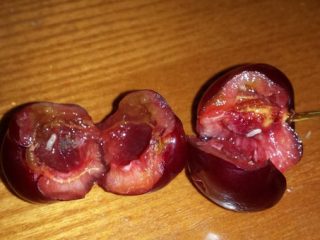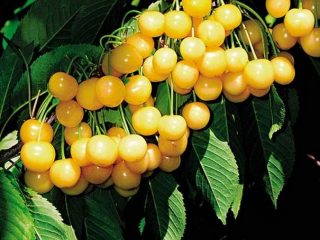Content
- 1 Do I need to prune cherries?
- 2 Types of cherry pruning
- 3 Pruning cherries in spring
- 4 Pruning cherries in summer
- 5 Several methods for forming a cherry crown
- 6 Tips for Beginner Gardeners
- 7 Conclusion
Pruning cherry trees is a critical procedure that performs many tasks. With the help of pruning, the appearance of the tree is formed, which is most suitable for good fruiting.
In addition, the procedure helps to get rid of old, broken, dry and diseased branches, which significantly rejuvenates the tree and contributes to its long life.
Do I need to prune cherries?
For anyone who has at least once encountered a wild fruit tree, such a question does not arise. Without pruning, the cherry tree will very soon turn into an overgrown, sloppy tree, the fruits will be crushed, and the crown will become very thick. This will worsen the access of air inside the crown, pockets of high humidity will appear there, which will, in turn, lead to the development of fungal diseases.
Types of cherry pruning
There are several types of cherry pruning, and each of them is done for a specific purpose.
- Formative. It is carried out during the first few years of life. The purpose of pruning is to form the tree crown of the desired shape. Time: early spring.
- Rejuvenating. It is carried out with the aim of replacing old shoots that have stopped producing crops with younger ones. Allows you to significantly rejuvenate an old tree and prolong its active fruiting. Old trees are rejuvenated in the spring.
- Sanitary. Its purpose is to rid the tree of dry, broken, dead and diseased shoots. It is carried out as planned in spring and autumn, as well as during the fruiting period in emergency cases, for example, damage to branches under the weight of fruit.
Pruning cherries in spring
Spring pruning of cherries is a rather responsible procedure. The video at the link below will help you understand its essence and avoid mistakes.
When to prune cherries in spring
The timing of spring pruning of cherries depends on the region of its growth. During this procedure, the tree must be at rest. For pruning, you need to choose a time when the average daily temperature will remain above 0 degrees Celsius, but the growing season of the cherry tree has not yet begun, i.e. the buds have not yet begun to swell.
Depending on the region, this time falls from the beginning of March (for southern regions) to the beginning of April (for more northern areas).
When can you cut down dry branches on a cherry tree?
All dry, broken, frost-damaged branches are removed at the same time as the main pruning. Particular attention should be paid to the condition of the tree bark. Branches damaged by rodents or showing signs of fungal diseases must also be removed. All cuts and cuts after pruning must be disinfected using an aqueous solution of copper sulfate, and the cut branches must be burned.
How to prune cherries correctly
There are several schemes that allow you to form the crown of a cherry tree in a certain way. With the help of annual pruning, the following types of crown can be formed:
- Stop leader.
- Australian bush.
- Bowl.
- Sparsely tiered.
- Spanish bush.
- Vogel.
- Flat crown.
- Triangle.
- Bush-like.
- Spindle.
Most often, gardeners form cherry tree sparsely tiered crown or cup-shaped.
Forming a cherry crown in the form of a bowl
The formation of a cherry crown in the form of a bowl is carried out for the following purposes:
- Reduce tree growth, thereby making it easier to harvest from the upper tier.
- Lighten the crown by increasing the amount of sunlight penetrating into the crown.
- Reduce crown density.
The bowl is formed as follows. After planting at a height of 0.5 m, the seedling is pinched. 5–6 shoots are left, evenly spaced around the circumference of the trunk. If necessary, they are bent so that they form the frame of the bowl.
Subsequently, all branches that grow inside the bowl must be cut out.
Rejuvenating pruning of cherries in spring: diagram
An adult tree may need rejuvenating pruning in the spring if there is a significant decline in its fruiting. In this case, new branches need to be grown to replace the old branches that bear fruit and weaken. To do this, a third of the shoots older than 5 years are removed annually. After a few seasons, the newly emerging shoots will completely form a new crown.
Pruning cherry trees to reduce upward growth
An adult cherry tree is a tall and powerful tree, so harvesting from the very top is very problematic. This issue can be partially resolved at the stage of forming the tree crown, forming it flat or in the form of a bowl.
Tying weights to branches is also widely used; under their weight, the shoots take a horizontal position. Various spacers and clothespins are also used to direct shoot growth not upward, but to the side.
Subsequently, the shoot will become woody and remain in this horizontal or inclined position.
Is it possible to prune flowering cherries?
Flowering cherry trees should not be trimmed.The flowering period is a time of intense sap flow, so any branch that has been shortened can simply dry out.
How to prune young cherries: diagram
The formation of the cherry crown begins from the first year of planting it in open ground. Depending on the type of crown being formed, pruning schemes are different.
Pruning old cherries
Old cherry trees are pruned in spring and summer. At this time, old branches 6–8 years old are removed. It is better to extend this procedure over several years, cutting out no more than 30% of the old crown at a time. Fruiting is transferred to the lateral branches, this simplifies both sanitary work with the tree and harvesting.
Pruning cherries in summer
The traditional time for pruning fruit trees is spring and autumn. However, cherries are also pruned in the summer.
The video below shows the main nuances of summer pruning of cherries.
Is it possible to prune cherries in summer?
In summer, it is possible and even necessary to prune cherries. At this time, excess green shoots that thicken the crown and tops are removed, and dry branches that were not noticed in the spring during sanitary pruning are cut out.
When can you prune cherries in summer?
Summer pruning is carried out in two stages. The first stage is crown thinning. It is done after the leaves bloom. The second stage is carried out after harvesting.
Pruning cherries in summer after flowering
After the end of the flowering period, when foliage appears on the branches, you can begin cleaning and thinning the crown. In early spring, it is difficult to determine which branches survived the winter well and which froze. In the summer everything is in plain sight. Dead branches simply won't produce leaves, so they need to be removed. If fungus appears on the shoots, they are also cut out and burned.
How to shape cherries using the pinching method
Shelling is pinching off the top of a growing shoot. It can be done simply with a fingernail, if the shoot is woody - with a garden knife or pruning shears. The shelling retards the growth of the shoot and gives impetus to the growth of lateral branches. Shelling reduces tree growth but increases its yield. In this way, you can stop the growth of the shoot in the wrong direction and direct it where you need it.
In order for the crown of a cherry seedling to be well formed, its shoot is pinched at a height of about a meter from the ground. By autumn, thanks to this, side shoots with good divergence angles will create the basis for the formation of a crown.
Forming a cherry tree crown without pruning
Cherries bear fruit only on horizontal shoots. Therefore, gardeners often simply bend vertical shoots to the ground, holding them in a horizontal position with the help of ropes, suspended weights, etc. This method can make a fruiting branch from a top.
Pruning cherries to increase yield
The easiest way to increase the yield of young cherries is to restrain the growth of annual growth, which can reach 1.2 m per year. Such shoots are pinched at a height of 60–80 cm. This will lead to the growth of shorter side shoots, on which fruits will appear.
Pruning cherries in the summer after fruiting
After harvesting, the second part of summer pruning of cherries is carried out. At this time, green non-lignified shoots that grow incorrectly, thicken the crown, as well as green tops are removed. The vertical shoots of the current year are shortened by a third.
Several methods for forming a cherry crown
The most common options for forming a cherry crown have already been listed earlier.These methods include crown formation using the KGB method, which is now rapidly becoming fashionable among gardeners.
Forming KGB cherries
The abbreviation KGB has nothing to do with the Soviet intelligence service. The abbreviation means Kym Green Bush, which translates as Kim Green bush. This Australian gardener was the first to propose such a technique for forming a low-growing cherry orchard.
Forming a cherry bush using the Kim Green method has a number of advantages:
- All cherries are approximately the same size.
- The bushes are compact and easy to use.
- The plant does not have old branches.
- Constant rejuvenation of the bush.
- Having a large number of leaders reduces the likelihood of freezing in winter.
- The system is simple and clear.
The video below shows the formation of a cherry tree crown using Kim Green’s method.
Pruning KGB cherries: how to prune in the first year after planting
After planting, the seedling is pruned at a height of 0.6 m from the ground. Over the summer, several shoots will appear on it. The 4 most powerful of them are left, and after they grow to a length of 0.6 m, they are shortened to a length of 0.15–0.2 m.
Formation of two-year-old cherries using the KGB system
By the end of next summer, shoots will grow on four stumps from last year. You need to leave 2 pieces on each of them, also cutting them to a length of 0.15–0.2 m. In total there will be 8 stumps.
Pruning three-year-old cherries using the KGB method
In the third year, 2 shoots are also left on each stump, bringing their total number to 16. If space allows, you can leave 20 shoots. By the end of summer, they are shortened so that the height of the tree is no more than 2–2.5 meters.
Formation of a cherry bush in the 4th year
In the 4th and subsequent years, branches shading and growing deep into the crown are cut out.The number of leaders is kept constant by removing the 4 or 5 thickest shoots per year and growing new ones instead.
Formation of cherries according to the “Australian bush” type with a diagram
The advantages of forming a crown using this type is that the crown is initially set to be low-growing. This greatly facilitates planting care and harvesting. In addition, the presence of several equally loaded trunks distributes the fruit load more evenly.
A video about shaping cherries using the Australian Bush method is below.
How to shape cherries in the first year of planting
After planting, the cherry seedling is shortened to 0.5 m. After the side shoots growing from the stump reach a length of 5–6 cm, 4 of them are left, extending from each other at approximately a right angle. Above them, ordinary clothespins are attached to the trunk, which direct the growth of shoots almost horizontally.
Formation of cherries in the second year of planting
In the second year, they continue to form a bush in the shape of a vase. To do this, in the spring, all growth buds that grow in the direction of growth deep into the crown are removed. Only gentle branches are left on the main shoots.
Cherry pruning scheme for the 3rd year
In the third year, all the growth of the current year is shortened to 8–10 cm. This is done so that it does not overly shade the bouquet branches.
Formation of cherries according to the “Australian bush” scheme in subsequent years
In subsequent years, all annual shoots are pruned so that the tree does not extend beyond its dimensions. Once every 5-6 years, pruning is carried out to rejuvenate the bush, removing 1/5 of the fruiting branches. Young shoots are grown in place of the removed shoots.
Formation of cherries according to the “Spanish bush” type
Molding cherries using this type is used mainly in southern countries. This is due to the fact that when forming a tree with a low crown, there is a high risk of losing the entire harvest during return frosts. The flower buds of tall trees practically do not freeze slightly at this time.
A video on how to shape a cherry tree like a “Spanish Bush” is below.
Pruning cherry "Spanish bush" with planting diagram
In spring, planted seedlings are pruned at a height of 35–70 cm. The height depends on the number of buds on the central conductor, as well as on the height at which it is desirable to obtain the main skeletal branches. The side shoots that appear in the summer (usually 4 pieces) are placed on a guy in order to obtain a large divergence angle. After the shoots grow to 50–60 cm, they are shortened to a level 15 cm above the leader.
In autumn, two trellises are stretched near bushes with plantings at ground level. They serve to fix second-order shoots. This allows for a more even distribution of branches and a more open crown.
Pruning two-year-old cherries according to the “Spanish Bush” pattern
In the second year, when the shoots grow to a length of 50–60 cm, they are cut in half. By autumn, third-order sprouts will be about half a meter long, and they also need to be made half as big.
There is no need to shorten horizontal shoots.
Formation of the cherry crown in subsequent years
Fruiting of cherries formed according to this type occurs on annual young shoots. To prevent the harvest from falling, the fruit-bearing branches are partially cut out (about a quarter of the total). In this way, constant rejuvenation of the bush occurs.
Cherries formed according to this principle should have a height of no higher than 2.5 m.Therefore, branches that exceed the dimensions of the crown, both in height and width, are trimmed to the required size.
Cherry pruning scheme “Sparse-tiered”
For a long time, a sparsely layered crown was considered optimal for the formation of a fruit tree. However, now more and more gardeners are starting to move away from this scheme. A tree formed in this way has a rather large height, which is inconvenient when working with it. However, the positive side is that with this scheme, cherry flowers are more resistant to spring return frosts, which allows you to save at least part of the harvest.
Pruning cherry seedlings after planting
In the first year, the planted tree is pruned at a height of 30–60 cm from the ground (the further south, the lower), leaving 4-6 buds on the trunk. Until next year, the seedling will produce powerful shoots from its buds.
Pruning two-year-old cherries
In the spring and summer of the second year, the first tier of the tree is formed. To do this you need to do the following:
- Select 3-4 of the strongest shoots, taking them as the basis for the lower tier.
- The shoot that extends the lowest from the trunk should be cut at a distance of 50–60 cm from the point of attachment to the trunk.
- Trim all other shoots at the same level from the ground as the very first one.
- Trim the central conductor, measuring its height 60–70 cm from the topmost branch and retreating 4 more buds.
How to prune a three-year-old cherry tree
In the spring and summer of the third year, the formation of the first tier of cherries continues and the second is laid. This is done like this:
- The weakest branch of the lower tier is determined. It is not cut.
- The growth of the remaining branches of the first tier should be cut to approximately the same level as this branch.
- Cut out branches growing at an acute angle to the main trunk (competing shoots), as well as branches growing inside the crown.
After this, they begin to form the second tier. To do this, do the following:
- Choose two strong branches directed outward in different directions and extending 30 cm or more from the central conductor. The rest are cut out.
- If necessary, the shoots are shortened to a level 10–15 cm below the shoot of the first tier.
- The central conductor is cut at a level of 50–60 cm above the level of the attachment point of the branches of the second tier, plus 4 more buds above.
Formation of cherries in the 4th year
In the fourth year, the formation of a sparsely layered crown is almost complete. At this time, the growth of the tree is limited, the central conductor is cut off above the weakest lateral branch. The branch itself is cut to a length of 0.5 m. The branches of the third tier are shortened, their length should be approximately 20 cm less than the length of the central conductor.
If the shoots of elongation of the skeletal branches of the first and second tiers grow by more than 0.7–0.8 m, then they are also shortened. Shoots directed into the crown, as well as tops, are completely removed. Shoots growing in the correct direction are cut to a length of 0.7 m.
Tips for Beginner Gardeners
For gardeners who have decided to take up pruning shears for the first time, it would be useful to study the theoretical part of the issue. The first pruning is best done with or under the guidance of a mentor. It must be remembered that improper pruning can simply kill the tree.
What tools are needed for pruning cherries?
High-quality garden tools are the key to tree health.When pruning, you need to remember that any damage, and especially a cut or cut, is an open wound through which infection or fungus can enter. The tool must be sharp, this will minimize the likelihood of unnecessary damage.
To carry out pruning in spring and summer, a gardener usually needs:
- Gardening scissors to remove green shoots.
- Secateurs.
- Lopper.
- Garden saw.
- Garden knife.
- Stepladder (for high areas of the crown).
Before the pruning procedure, all tools must be disinfected with a solution of copper sulfate.
How to cut branches correctly
Branches need to be trimmed so as to cause as few wounds to the tree as possible. For example, when removing a branch coming from the trunk, you need to be careful not to touch the pocket of bark at the bottom of the branch attachment, as well as the scar of bark that is located on top. This kind of sleep will drag on very quickly. If you cut close to the trunk, the wound will be very large; if you retreat far, you will get a large knot.
It is better to first saw large branches from below, otherwise they, breaking from their own weight during filing, can tear off a piece of living bark. On branches, the cut must be made from below. When using pruning shears, you need to cut slightly obliquely, right above the bud.
In what weather do you prune cherries?
Pruning is not carried out at subzero temperatures, since the wood is quite fragile at this time. It is also undesirable to prune in damp, cold weather, as this promotes gum growth.
Processing of slices after trimming
The cuts and saw cuts remaining after the pruning procedure must be disinfected with a solution of copper sulfate and covered with garden varnish. This is especially true for large cuts.Increased attention should be paid to treating wounds if pruning was carried out for sanitary purposes, for example, wood affected by fungus was removed.
The saw cuts can also be treated with ordinary oil paint on a natural basis. It is better to use natural garden pitch, based on fir resin, rather than petroleum products.
Conclusion
Pruning cherries in spring and summer helps the tree remain healthy for a long time and delight the gardener with an excellent harvest. There are quite a lot of nuances in carrying out this procedure, however, there is enough information on this topic to master all the intricacies of pruning.
